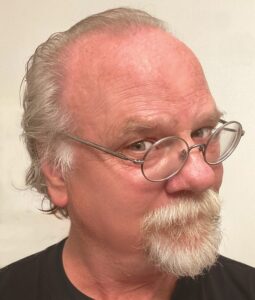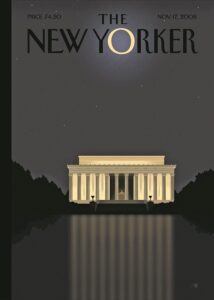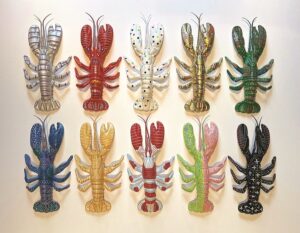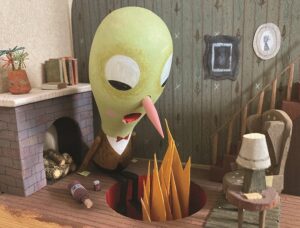“I can tell you right now as a fact,” says Bob Staake, “that a six-year-old child has never walked into a bookstore and laid down $18.99 for a children’s picture book. It’s never happened — OK?”

He should know. Staake has written or illustrated more than 75 children’s books. To sell books, he says, it is the parents and grandparents from whom Staake must elicit “a snicker or a giggle.” Staake, who lives in Chatham, has also published illustrations in the New York Times, the Washington Post, the Los Angeles Times, the Miami Herald, the Wall Street Journal, and the New Yorker. He clearly knows how to engage grown-ups.
But at the Cape Cod Museum of Art in Dennis, where “The Endless Imagination of Bob Staake,” an exhibition spanning 50 years, is on view through Oct. 15, grown-up museumgoers might feel they’ve become children again. Hanging from the ceiling is Staake’s AIRPLAY, a giant mobile with colorful abstract icons that spin in the breeze emitted by the museum’s ventilation system. It’s a joyful and unapologetic claiming of space, but so is the rest of the exhibition with hundreds of works.
There are Staake’s illustrated product and brand posters on one wall; on the opposite wall, there’s a row of “fauxsters,” or “fake posters,” for fictitious products and consumer goods. There are small cartoonish wooden sculptures and painted lobsters, called “Bobsters,” hidden around the exhibition like clues in a treasure hunt. There is a wall full of Staake’s New Yorker covers, including Reflection, published on Nov. 17, 2008 after Barack Obama’s election.
Staake has publicly rejected the idea that he has a “style” — his works are too different, he says, his way too experimental. But every piece in the show, he admits, looks like a Bob Staake. “There’s something hiding in the background,” he says, whether the piece is photorealistic, “completely silly,” design focused, or aesthetically midcentury modern. “Maybe it’s a point of view, maybe it’s a sense of composition,” he says. Maybe it’s his interest in “communicating, entertaining, engaging with people.”
Staake didn’t take an art class past high school. He graduated in 1977 from the University of Southern California with a double major in print journalism and international relations. “I had wanted to become a political cartoonist,” he says. “I knew that the art would never be a problem — that was self-taught.”

Political cartoonists, he says, “aren’t aesthetically minded whatsoever” — a great political cartoon is “90 percent idea, 10 percent drawing.” That mindset has suffused his career, in some ways: one of his New Yorker covers was done in 15 minutes, he claims.
Staake has ideas — sometimes too many. “I don’t have time to belabor anything, to get all anal about the right lighting,” he says. “I don’t need to make sure that everything’s in perfect order before I can possibly touch a piece of paper. If you need that, you should not be an illustrator. I’ve always been one of those people who just dives in.”
Staake didn’t dive into this solo show. When the museum first called him 10 years ago, Staake wouldn’t pick up the phone.
“Anytime I’m asked to have a piece in a show, I try to find a way not to do it,” he says. “Especially if it’s a digital piece, and I’ve got to print the giclee, map the giclee, frame the giclee. I’ve got to package up the whole frame, ship it off, track it. Follow up on it when I don’t get it back. It’s just a huge pain in the ass. I hate it.”
But things were different this time. In the last 10 years, Staake has made more things — “things that would make for a better show, frankly.” There are the Bobsters and a wall of fine art Staake creates strictly for his own pleasure. He’s dug up early sketches, pen on yellowed paper. There’s a recreation of his desk and workspace, including a long, high shelf cluttered with objects that inspire his illustrations: decapitated doll heads, toy robots, a plastic dinosaur. Staake made AIRPLAY specifically for this show.

“If you want to tell the story of my life as an illustrator, then you’ve got to show all that stuff,” he says. “And this sounds really kind of trite, but what you see in that show is not even one percent of the work that I’ve produced. Not even close.”
Staake has notebooks filled with “nothing but story ideas” — bits of text, snippets of dialogue, doodles. “Here’s a doodle,” he says, flipping through the worn pages of one notebook. It’s a simple image: “The Narwhal and the Unicorn.”
One story idea is called “The Last Leaf.” “I was on the bike path in Harwich,” he says. “It was in the fall, and I found a leaf that had three holes in it. Two on the top and one on the bottom. It looked like a face, and I thought, there’s a story there about a leaf holding on to a tree for dear life. The last one, you know, that absolutely refuses to fall.”
When he writes a children’s book, says Staake, he remembers “five-year-old Bobby Staake in Redondo Beach, Calif. And I ask myself, what would he want to see?” He knows he must appeal to adult book buyers, but he doesn’t discount the child’s sensibility.
Editors, he says, are too critical: “I ask myself, are book editors spending a lot of time with kids? They say, ‘Oh, I’m not sure about this, it seemed kind of obvious,’ or ‘Boy, this is really silly.’ I say to them, ‘You have to understand that you’re an adult. To you, it’s obvious. A six-year-old kid is going to be amazed, startled at this little plot twist — they won’t see it coming. And they won’t have a problem with it being super silly.’ ”

Staake’s gut tells him when he has a good story, he says. “The more freedom a client gives me,” he says, “the better the project will be. It’s that simple.” And the older he gets, “Doing it my way is more important than ever.”
The small sculptures in the CCMOA show are made of scrap wood from two woods shops at his house. He saves the scraps for fun. Half-circle, triangular, and rectangular pieces become people and animals: characters. It’s that playful spirit that defines him.
“I never go into a project with anxiety or dread,” he says. Not a New Yorker cover, not an advertisement with a strict deadline, not a children’s book where, Staake says, “You’re the screenwriter, the art director, the costumer, the lead actor, the supporting actor, the executive producer, the director, the lighting designer, the editor.
“When I go to bed, I keep something on my desk that’s not complete. I want to think, ‘I can’t wait to go ahead and paint that locomotive. That cloud in the background — that cloud’s not right. How am I going to fix that? Oh, I know. I’ll invert it. I’ll make it more abstract.”
Staake is always solving a problem; that’s what excites him. “It’s like the color of a background that you’re not quite sure about,” he says. “Then it’s like, well, maybe I’ll make it more of a pink, and all of a sudden the thing really sings.”
The Life of an Illustrator
The event: “The Endless Imagination of Bob Staake”
The time: Through Oct. 15
The place: Cape Cod Museum of Art, 60 Hope Lane, Dennis
The cost: General admission: $10



